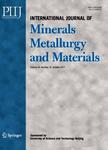Microstructure,crystallography and nucleation mechanism of NANOBAIN steel
Microstructure,crystallography and nucleation mechanism of NANOBAIN steel作者机构:Metallurgy Engineering Research InstituteUniversity of Science and Technology Beijing School of Material Science and EngineeringJiangxi University of Science and Technology
出 版 物:《International Journal of Minerals,Metallurgy and Materials》 (矿物冶金与材料学报(英文版))
年 卷 期:2013年第20卷第12期
页 面:1155-1163页
核心收录:
学科分类:08[工学] 080502[工学-材料学] 0805[工学-材料科学与工程(可授工学、理学学位)]
基 金:financially supported by the National Natural Science Foundation of China (No.51271035)
主 题:nanostructured materials high strength steel bainitic transformations microstructure crystallography nucleation
摘 要:The microstructure of bainite ferrite in NANOBAIN steel transformed at different temperatures was investigated by scanning electron microscopy, transmission electron microscopy, electron back-scattered diffraction, and vickers hardness tester in detail. It is found that the average width of bainitic ferrite (BF) plates can be refined to be thinner with the reduction of temperature (473-573 K), and the bainitic ferrite plates can reach up to 20-74 nm at 473 K. Crystallographic analysis reveals that the bainitic ferrite laths are close to the Nishiyama-Wasserman orientation relationship with their parent austenite. Temperature shows a significant effect on the variant selection, and a decrease in temperature generally weakens the variant selection. Thermodynamic analyses indicates that the Lacher, Fowler and Guggenheim (LFG) model is more suitable than the Kaufman, Radcliffe and Cohen (KRC) model dealing with NANOBAIN steel at a low temperature range. The free energy change △G^γ→BF is about -1500 ***^-1 at 473 K, which indicates that nucleation in NANOBAIN steel is the shear mechanism. Finally, the formation of carbon poor regions is thermodynamically possible, and the existence of carbon poor regions can greatly increase the possibility of the shear mechanism.




